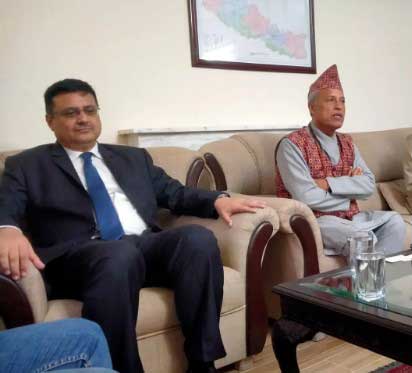Nepali scholar Dr Bhola Nath Yogi passionately calls for peace, sheds light on the Nath tradition

Celina Ali
Islamabad: Dr. Bhola Nath Yogi, a respected scholar from Nepal, passionately called for peace and unity among followers of all religions. He also shed light on the Nath tradition, which is a Shaiva sub-tradition within Hinduism prevalent in Nepal, Pakistan, and India.
This Nath tradition, also known as the Natha tradition, emerged during medieval times and incorporated elements from Buddhism, Shaivism, and Yoga traditions of the Indian subcontinent. Dr. Yogi emphasized that the Naths are a community of devotees who consider Shiva as their primary lord or guru, with varying lists of additional spiritual guides.

Key figures in this tradition, including Matsyendranath and Gorakhnath, played pivotal roles in shaping the Nath Panth. The Nath tradition has a rich theological literature rooted in Shaivism and Siddha traditions, dating back to ancient times.
One notable aspect of Nath practice involves the refinement and utilization of Yoga, particularly Hatha Yoga, as a means to attain self-realization and unity with the ultimate reality. The guidance of a proficient guru is of paramount importance in the Nath tradition, known for its esoteric and unconventional practices.
The Naths challenged conventional beliefs by exploring unorthodox aspects of society in their quest to understand theology and gain inner strength. They established monastic organizations and itinerant groups that embarked on spiritual journeys to sacred sites and festivals like the Kumbh Mela.
In addition to its monastic groups, the Nath tradition also has a settled householder tradition. Interestingly, during the Islamic rule in the Indian subcontinent, some members of the tradition transitioned into warrior ascetics.
Dr. Yogi pointed out that the Nath tradition has had a significant influence on various other traditions, including Advaita Vedanta, Vaishnavism, Shaktism, and the Bhakti movement, with notable figures like Kabir and Namdev being influenced by it.
The term “Nath” is derived from Sanskrit, signifying “lord,” “protector,” or “master.” Initiation into the Nath sampradaya typically involves receiving a name ending in -nath, -yogi, or -jogi.
It’s worth noting that while the term ‘Nath’ gained prominence in the 10th century with Matsyendranath, during the colonial rule, yogis were marginalized and labeled as a “low-status caste.” In response, the community began using the term “Nath” more prominently in public relations.
The Nath tradition traces its lineage back to Shiva as the first guru, Adinatha, and comprises a list of nine Nath gurus, which can vary according to regional traditions. The tradition’s origins can be traced to the ancient Siddha tradition, which explored human perfection through psychological, alchemical, and physical techniques.
Primarily concentrated in the Deccan region and peninsular India, with some mentions in eastern India, the Nath tradition gradually incorporated Dattatreya and expanded to include Vishnu-Shiva syncretism. The number of Nath gurus varied across texts, with the 15th-century Telugu text Navanatha Charitra mentioning nine Nath gurus.
Although early scholars had suggested Buddhist origins for the Naths due to mentions in Tibetan and Himalayan texts, the Nath tradition’s doctrines and theology significantly differ from mainstream Buddhism. The Nath Yogis were highly regarded by the Bhakti movement saint Kabir.
This enlightening lecture by Dr. Yogi was hosted by the Ambassador of Nepal to Pakistan, Tapas Adhikari.





